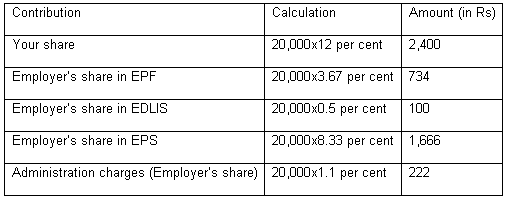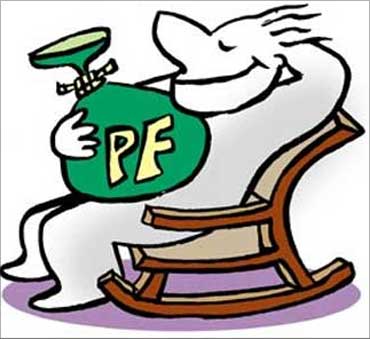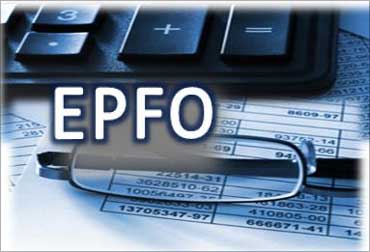Photographs: Rediff Archives
Did you know that your EPF contribution also goes towards insuring you, giving you and your spouse a pension apart from giving you a lump sum amount after retirement?
The Employee Provident Fund (EPF) or simply Provident Fund (PF) is a long-term savings and pension instrument for all salaried persons in India. Any organisation having over 10 employees is required to register with the Employee Provident Fund Organisation (EPFO).
For all employees in such an organisation who draw a basic monthly salary of Rs 6,500 or less, the PF is mandatory. For all others, the PF is optional -- such employees can opt out of the PF at his discretion. We at Fintotal however recommend all employees to avail of the PF, since it's a great long-term savings instrument. The returns are high, tax-free and safe; and its lock-in fights our propensity to spend the money away.
The author is director at Fintotal Insights and Resources Pvt Ltd. He can be reached at info@fintotal.com.
Courtesy: 
How your Employee Provident Fund benefits YOU
Photographs: Rediff Archives
Contribution to Employee Provident Fund
You as an employee contribute 12 per cent of your Basic Pay towards your PF every month. This is typically deducted from your salary before being credited into your Bank.
Your employer pays 13.61 per cent of your basic and adds it to your account.
That’s 25.61 per cent of your Basic Pay.
Not all the contribution goes to PF though.
Part of it goes towards administration charges (1.11 per cent in all). Another part goes to the Employee Deposit Linked Insurance Scheme or EDLIS (0.5 per cent). A portion goes to an Employee Pension Scheme or EPS (8.33 per cent).
The remaining (15.67 per cent) goes to the PF itself.
If your basic pay comes to Rs 20,000 here is what the typical break up of EPF contributions will look like:

How your Employee Provident Fund benefits YOU
Photographs: Rediff Archives
Who manages provident funds?
Some organisations manage their own PF and register this with Income Tax and the Labour Ministry. Others use the services of the EPFO to manage their fund. In either case, the returns to you as an employee remain the same.
Currently, the PF is allowed to invest only in debt -- such as government bonds. It is not allowed to invest in equity, though there have been some demands to allow it to invest a small portion in equities.
The interest that the PF pays is independent of the performance of the fund, and is fixed by the Board of Trustees that manage the PF. The current interest rate it pays is 8.5 per cent (tax-free).
The EPS is separately managed, and is used to provide life pension to the individual and spouse after retirement.
The EDLIS goes to pay life insurance to the family members of the PF member in case of her/his death during employment.
The EDLIS has a maximum payout of Rs 1 lakh, and is equal to the average balance in the PF account in the last 12 months. This is paid back over and above the return of the PF itself.
How your Employee Provident Fund benefits YOU
Photographs: Rediff Archives
You can fully withdraw your PF once you attain 55 years of age. You can also withdraw it earlier if you are out of a job for over six months. However, in such a case, if you have had the PF for less than five years, the PF becomes taxable.
In the interim years, you are allowed to borrow from your PF for a variety of uses such as house construction, child’s education, treatment of illness, injury, etc. You may contact your finance department in case of such special needs.
Of course, given that PF is primarily a retirement corpus, we would strongly advise against utilising PF money for other assets or expenses -- remember, its your own money you are eating away!
The Employee Pension Scheme can be used after retirement to draw a monthly pension. This is also payable to the widow after the death of the individual.
Up to one-third of the corpus in the EPS can be commuted (i.e. withdrawn immediately) and the rest needs to be compulsorily taken as pension. The valuation of the EPS and pension amounts are complicated and we will not go into them here. But suffice it to know that this is a safe and risk-free basic pension. Of course, it is unlikely to be enough in itself, especially when compared to inflation. Thus, separate pension planning needs to be done. But this is a good starting point.
Summary
In summary, the PF and the associated pension schemes are useful tools given by the Government to facilitate retirement planning. All employees can use these schemes as a starting point. However, in themselves, they are unlikely to be adequate to cover all retirement and pension needs, especially with our exploding prices and lifestyles. Thus, retirement needs to be planned separately (in addition to the PF) too.





Comment
article